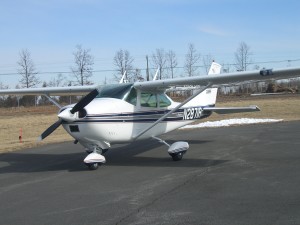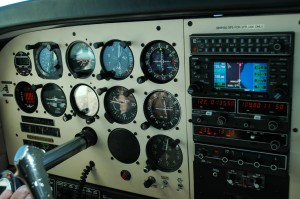Old Airplane, New Technology
When non-pilots ask how old my flying club’s Cessna 182 Skylane is, I have become accustomed to the inevitable shock when I tell them that it rolled out of the factory in 1967. That’s why I have a well-rehearsed follow-up stating that our airplane is the newest 40-something airplane on the ramp, having been substantially reconstructed after a deer strike in the summer of 2006. That tidbit generally erases the non-pilot’s doubts about safety, but it really doesn’t do justice to the effort that we-like so many other general aviation pilots-have gone to ensure that our older airplane is equipped to operate in the brave new world of NextGen technology.
 Bit by Bit. I seriously doubt that the original owner of our airplane would recognize anything but the tail number. That’s partly because our Skylane sports a spiffy new paint scheme courtesy of the reconstruction required when Bambi bashed into the empennage. A decade ago, we voted to refurbish the instrument panel. Out went the cracked and faded plastic, and in came a powder-coated metal panel. It was an obvious aesthetic improvement, but the real benefit was the opportunity to move the basic instruments into the standard six-pack configuration.
Bit by Bit. I seriously doubt that the original owner of our airplane would recognize anything but the tail number. That’s partly because our Skylane sports a spiffy new paint scheme courtesy of the reconstruction required when Bambi bashed into the empennage. A decade ago, we voted to refurbish the instrument panel. Out went the cracked and faded plastic, and in came a powder-coated metal panel. It was an obvious aesthetic improvement, but the real benefit was the opportunity to move the basic instruments into the standard six-pack configuration.
The next big leap in technology came just a few years ago when the sale of the  club’s underutilized Cessna 150 gave us the capital for a few more upgrades. The number one item on our shopping list was a GPS moving-map navigator. It was goodbye to the LORAN-C and an enthusiastic hello to the Garmin GNS 430. IFR-certified from the start, the GNS 430 was our admission ticket to the vastly increased RNAV and performance-based navigation (PBN) possibilities that GPS can offer.
club’s underutilized Cessna 150 gave us the capital for a few more upgrades. The number one item on our shopping list was a GPS moving-map navigator. It was goodbye to the LORAN-C and an enthusiastic hello to the Garmin GNS 430. IFR-certified from the start, the GNS 430 was our admission ticket to the vastly increased RNAV and performance-based navigation (PBN) possibilities that GPS can offer.
That world got bigger still when we exercised the option to upgrade our original unit to WAAS (Wide Area Augmentation System) capability. WAAS lets us take full advantage of the new augmented GPS approaches that the FAA’s Flight Technologies and Procedures Division is busily developing.
Although it wasn’t as glamorous as the GPS, another useful bit of technology that we financed through the C150 sale was a sophisticated engine monitor. The ability to monitor our powerplant’s health in almost excruciating detail has resulted in operating guidelines and procedures that have doubtless extended its life.
Still on the Wish List. Not surprisingly, the members of my flying club are full of ideas for spending our capital improvement budget. A near-term priority for upgraded technology is a 406 MHz emergency locator transmitter (ELT). It isn’t required, but it’s hard to argue against the safety benefits now that satellites no longer monitor ELTs on the traditional 121.5 guard frequency. Like many pilots, we are also trying to position our Skylane – and our budget – to take advantage of upcoming NextGen developments. Our club members recently voted on a prioritized “wish list” that includes considering items such as retrofitted “glass cockpit” avionics and the equipment we would need to benefit from ADS-B technologies. Although the pesky realities of financing mean that some of the bigger changes are still a few years away, the bottom line is that we are working to ensure that our Skylane will be efficiently navigating the National Airspace System (NAS) for many years to come. (FAA Safety Briefing – MayJune 2010)
